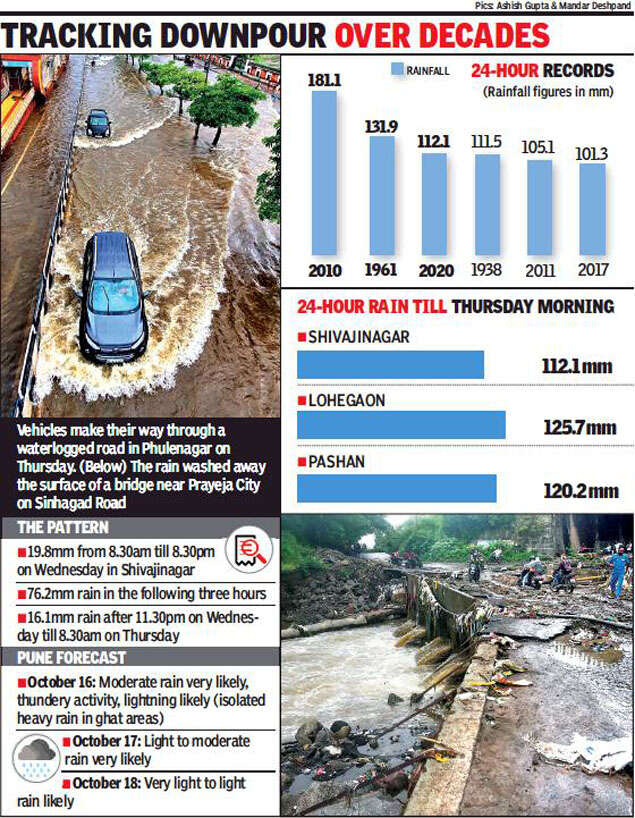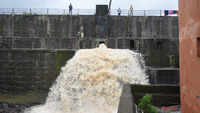
PUNE: The rainfall in the city till Thursday morning not only shattered its October records of the past decade for 24-hour showers, but its quantum was also the third highest for the month in 120 years.
The three locations here recorded triple digit showers (from 8:30am on Wednesday till 8:30am on Thursday), more than rain hotspots such as Mumbai, Lonavla and some other ghats, with 112.1mm rain in Shivajinagar, 125.7 in Lohegaon and 120.2mm in Pashan.

Data for the past few years revealed that very heavy rainfall events in a span of a few hours have been occuring especially during the past two years. Climate scientists attributed the trend to global warming.
Pulak Guhathakurta, head of the climate research division, India Meteorological Department (IMD) Pune, told TOI, “In the past decade and as well
as 120 years, the highest 24-hour October rainfall was recorded on October 5, 2010, at 181.1 mm. The second highest 24-hour October rainfall was recorded in 1961 at 131.9mm. Wednesday night’s rain is now the third highest in over a century.”
Guhathakurta said the trend of the increased frequency of heavy rainfall events was being observed across India. “This is a result of climate change,” he added.
Initial estimates by the agriculture officer suggest crops on over 5,000 hectare area in 13 tehsils across Pune district may be damaged due to heavy rainfall The state issued fresh directives to all the revenue divisional commissioners to carry out panchanamas to assess the crop damage due to the incessant rain in October. As per instructions, all the farmland with over 33% losses are to be put on record and categorized into ‘A’, ‘B’, ‘C’ and ‘D’ groups.
24-hour Pune rainfall third highest for Oct in 120 years
Scientists Say Reduction Of Open Spaces Caused Waterlogging
IMD data on Wednesday revealed that while Shivajinagar received about 19.8mm rain from 8:30am till 8:30pm, the three hours that followed did the maximum damage with almost 76.2mm rain during the period. After 11:30pm, Shivajinagar received 16.1mm rain, totalling to 112.1mm till 8:30am on Thursday.
The rain in Pune was a result of moisture incursion from the depression earlier over the north interior Karnataka and its adjoining areas of Maharashtra and Telangana. By early Wednesday evening, the system began entering Maharashtra, passing Marathwada. By evening, the system had already turned into a wellmarked low pressure area. By Wednesday night, the intensity of the rain increased over Pune as the well marked low pressure system neared Baramati.
IMD director general Mrutyunjay Mohapatra told TOI, “Climate change and global warming have had an impact, as the amount and intensity of rainfall have increased in parts of the country in association with low pressure systems.”
Another IMD scientist said, “In a 30-year-span, there can be a 10-15% rise in rainfall due to climate change, sometimes in an individual case. But that is not as significant as the real problem: changes in the land use pattern, which have been mainly responsible for flooding events in Pune, as open spaces have reduced significantly, causing waterlogging.”
JR Kulkarni, former chairman of the Indian Meteorological Society, said, “Climate change studies have shown rise in October rain, by about 3mm per year, since the 1980s in states such as Maharashtra, Andhra Pradesh, Telangana and Karnataka.” He said, “Global warming and associated increase in temperature may have increased the atmosphere’s moisture holding capacity. If there is a one-degree rise in day temperature, the moisture holding capacity of the atmosphere increases much more. Hence, the much higher amounts of rain.”
The three locations here recorded triple digit showers (from 8:30am on Wednesday till 8:30am on Thursday), more than rain hotspots such as Mumbai, Lonavla and some other ghats, with 112.1mm rain in Shivajinagar, 125.7 in Lohegaon and 120.2mm in Pashan.

Data for the past few years revealed that very heavy rainfall events in a span of a few hours have been occuring especially during the past two years. Climate scientists attributed the trend to global warming.
Pulak Guhathakurta, head of the climate research division, India Meteorological Department (IMD) Pune, told TOI, “In the past decade and as well
as 120 years, the highest 24-hour October rainfall was recorded on October 5, 2010, at 181.1 mm. The second highest 24-hour October rainfall was recorded in 1961 at 131.9mm. Wednesday night’s rain is now the third highest in over a century.”
Guhathakurta said the trend of the increased frequency of heavy rainfall events was being observed across India. “This is a result of climate change,” he added.
Initial estimates by the agriculture officer suggest crops on over 5,000 hectare area in 13 tehsils across Pune district may be damaged due to heavy rainfall The state issued fresh directives to all the revenue divisional commissioners to carry out panchanamas to assess the crop damage due to the incessant rain in October. As per instructions, all the farmland with over 33% losses are to be put on record and categorized into ‘A’, ‘B’, ‘C’ and ‘D’ groups.
24-hour Pune rainfall third highest for Oct in 120 years
Scientists Say Reduction Of Open Spaces Caused Waterlogging
IMD data on Wednesday revealed that while Shivajinagar received about 19.8mm rain from 8:30am till 8:30pm, the three hours that followed did the maximum damage with almost 76.2mm rain during the period. After 11:30pm, Shivajinagar received 16.1mm rain, totalling to 112.1mm till 8:30am on Thursday.
The rain in Pune was a result of moisture incursion from the depression earlier over the north interior Karnataka and its adjoining areas of Maharashtra and Telangana. By early Wednesday evening, the system began entering Maharashtra, passing Marathwada. By evening, the system had already turned into a wellmarked low pressure area. By Wednesday night, the intensity of the rain increased over Pune as the well marked low pressure system neared Baramati.
IMD director general Mrutyunjay Mohapatra told TOI, “Climate change and global warming have had an impact, as the amount and intensity of rainfall have increased in parts of the country in association with low pressure systems.”
Another IMD scientist said, “In a 30-year-span, there can be a 10-15% rise in rainfall due to climate change, sometimes in an individual case. But that is not as significant as the real problem: changes in the land use pattern, which have been mainly responsible for flooding events in Pune, as open spaces have reduced significantly, causing waterlogging.”
JR Kulkarni, former chairman of the Indian Meteorological Society, said, “Climate change studies have shown rise in October rain, by about 3mm per year, since the 1980s in states such as Maharashtra, Andhra Pradesh, Telangana and Karnataka.” He said, “Global warming and associated increase in temperature may have increased the atmosphere’s moisture holding capacity. If there is a one-degree rise in day temperature, the moisture holding capacity of the atmosphere increases much more. Hence, the much higher amounts of rain.”

Coronavirus outbreak
Trending Topics
LATEST VIDEOS
City
 On cam: Fort wall collapses after heavy rains in Telangana
On cam: Fort wall collapses after heavy rains in Telangana  Kerala gold smuggling case: Accused have links with Dawood Ibrahim, says NIA
Kerala gold smuggling case: Accused have links with Dawood Ibrahim, says NIA  'Red light on, gaadi off': Delhi CM Arvind Kejriwal urges people to take pledge to reduce air pollution
'Red light on, gaadi off': Delhi CM Arvind Kejriwal urges people to take pledge to reduce air pollution  Delhi Unlock 5: Movie theatres reopen with limited seating capacity
Delhi Unlock 5: Movie theatres reopen with limited seating capacity
More from TOI
Navbharat Times
Featured Today in Travel
Quick Links
Get the app





